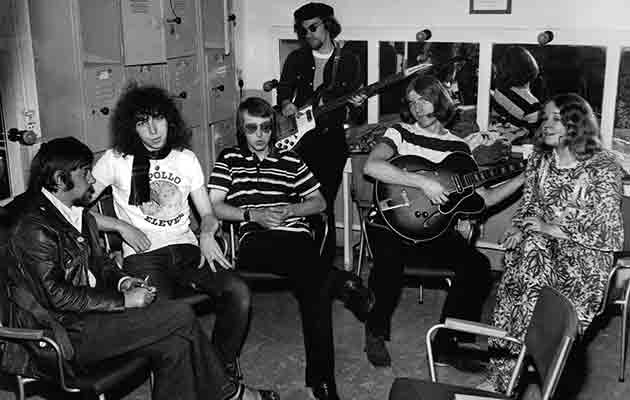They were a bunch of uptight Londoners who wanted to be The Byrds. But after a tragic road crash, Fairport Convention holed up in the countryside, tapped into mystical traditions and reinvented English folk-rock. Nearly 40 years later, they remember: “We were on a crusade...” Originally publish...
The photos that exist of the group at Farley Chamberlayne have taken on the mantle of the ultimate English idyll, an artistic exploration undertaken in tranquility. The group dawdle on the lawn of the Queen Anne-style house in the golden sunlight of late summer. They rehearse in their oak-floored, brocade-curtained music room, with amplifier lights winking through the fug of cigarette smoke and bronze sunbeams glowing at the French windows. The ancient conifer tree, with its tattered rope swing, still lords it over the lawn nearly 40 years later.
In such seclusion, there was nothing else but to knuckle down to several months’ hard work. “We had a music room,” recalls Swarbrick, “and we went into it every day, from early in the morning to late at night. We religiously worked very hard. I’m talking 12, 14 hours a day. We knew that we didn’t have Farley Chamberlayne forever – it was an expensive place to rent. We had a project; everybody was, dare I say, young, and well fired-up – hormones all over the bleeding place!”
“It was a magical time,” confirms Hutchings. “And there’s a lot of magic on that album. There was a special feeling in the house, in the room, and also a lot of hidden magic and weirdness on that album. The past is weird, you know, our ancestors did a lot of weird things.”
“Out of the four nations that comprise the UK,” says Swarbrick, “England is the only one that had to have a folk revival. Apart from a few pockets, like the north east and Cornwall, it was pretty well dead everywhere else.” As a musician, if you dabbled in folk at all, you entered an ideological minefield rife with fundamentalism: should anyone other than a Yorkshireman sing a Yorkshire song? Should lyrics even be accompanied by instruments at all? For a group of twentysomething longhairs like Fairport to breeze in and blast out classics like “Matty Groves” and Tam Lin” with electric instruments was, for some listeners, akin to Dylan’s legendary “Judas” moment.
“There were people in the hardcore folk movement who saw us as taking liberties with ‘their’ music,” says Nicol. “It’s a preposterous attitude, because they’re just songs, they don’t exist under glass, they’re not exhibits in a museum that you have to preserve in amber.”
In any case, remembers Swarbrick, the English folk circuit was in a pretty stagnant state by the end of the decade. “I used to go out with Ian Campbell to pubs and all you could hear was the dominoes clinking. It was an effort to get things going.”
“So much of the developments in traditional folk music are academically driven,” adds Hutchings. “But for us it was a natural thing. There would always be earnest, dry sleevenotes on any traditional album saying exactly where a song came from, how many years old it was and so on. Whereas we just leapt in and did this in a rock’n’roll kind of way. We weren’t concerned with being historically accurate, it was rock’n’roll. And it blew a lot of cobwebs away. We were on a kind of crusade.”
“Nothing resonates like an old song,” says Thompson. “To sing something beautifully written, and then refined over hundreds of years, that still has meaning and urgency, that still creates vivid pictures in the mind, is a deeply rewarding thing. I think we hoped the band would achieve some mainstream popularity, so that we could bring the tradition a little closer to people’s lives. This has happened more in Ireland and Scotland, but the English still seem to see their own culture as an embarrassment or a novelty – it’s that post-empirical confusion.”



